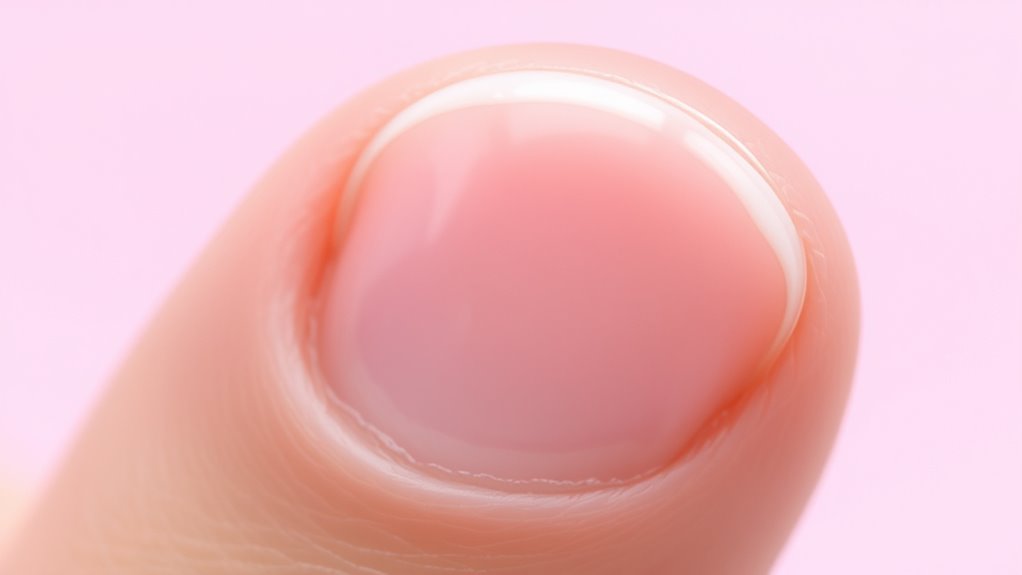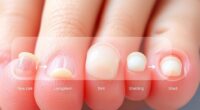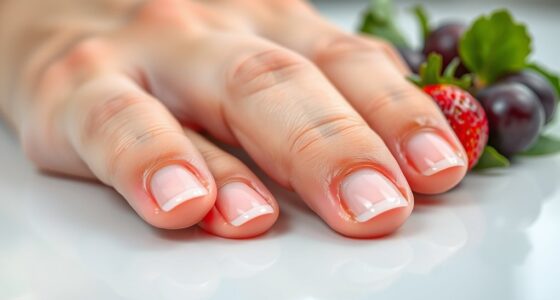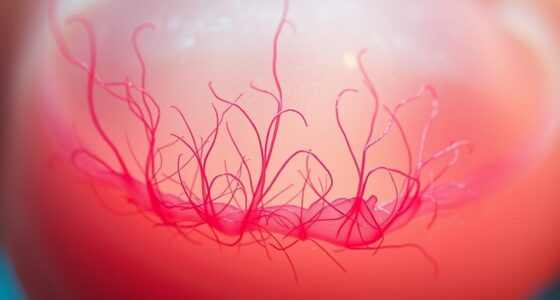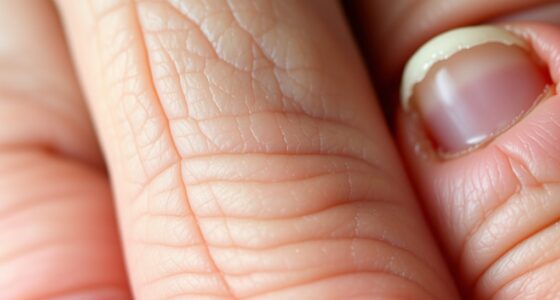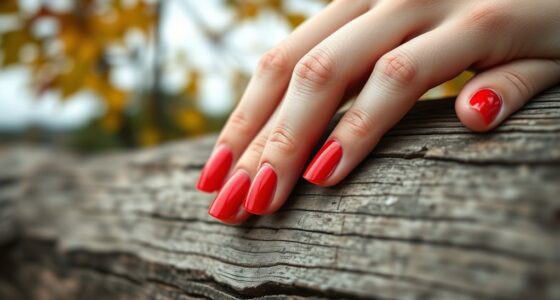A healthy nail includes a strong, smooth nail plate made of keratin that protects your fingertips. It sits on a nourishing nail bed and features a visible lunula, the white half-moon shape indicating growth. The cuticle and nail folds act as barriers, keeping out dirt and infections. Blood vessels and nerve endings support and sense the nail’s health, ensuring proper growth and protection. If you want to know how each part works together, keep exploring.
Key Takeaways
- The nail plate is a keratinous, hard surface that protects the fingertips and supports nail polish applications.
- The nail bed supplies nutrients, supports growth, and gives the nail its pink coloration through rich blood flow.
- The lunula is the white, crescent-shaped area indicating healthy nail matrix activity.
- The nail matrix at the base produces new nail cells essential for ongoing growth and repair.
- The cuticle and nail folds form protective barriers that prevent infections and external damage.
The Nail Plate: The Visible Part of Your Nail
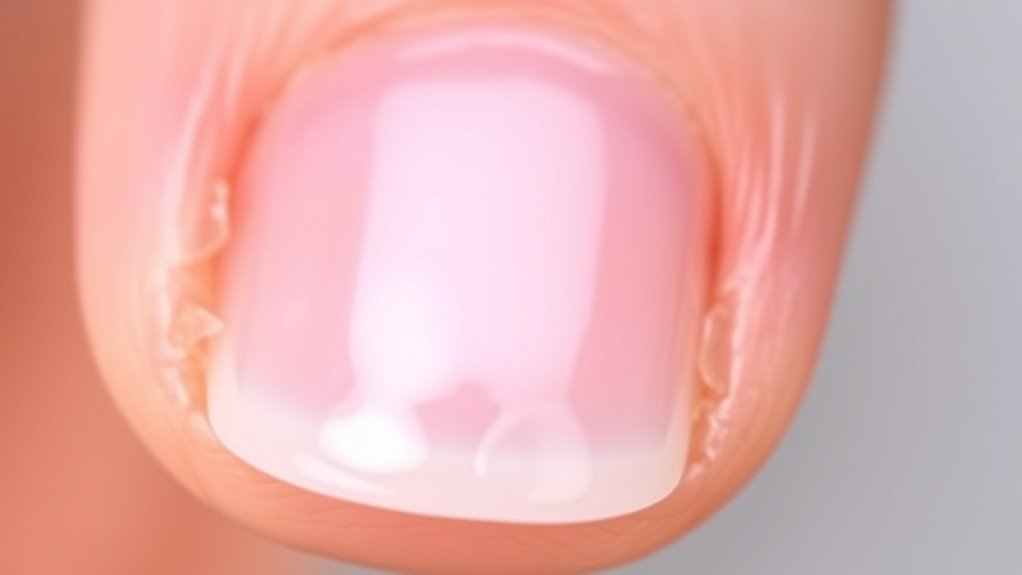
The nail plate is the hard, visible part of your nail that protects your fingertips. It’s primarily made of keratin, a tough protein that provides strength. When you apply nail polish, it sits directly on this surface, adding color and style. Acrylic nails also adhere to the nail plate, enhancing length and durability. Proper care of the nail plate is essential because damage or infections can compromise its integrity. Avoid using harsh chemicals or picking at your nails, as this can thin or weaken the plate. Keep your nails clean and moisturized to maintain their health. Whether you’re sporting a fresh coat of polish or acrylic enhancements, a healthy nail plate acts as the foundation for a polished, attractive look. Protecting the nail plate from damage is crucial for overall nail health. Recognizing signs of infection or damage early can prevent more serious issues and preserve nail strength. Additionally, understanding the importance of biological components like keratin can help you better care for your nails and prevent deterioration. Regular maintenance and avoiding trauma are key to keeping the nail structure resilient and healthy.
The Nail Bed: Foundation and Support
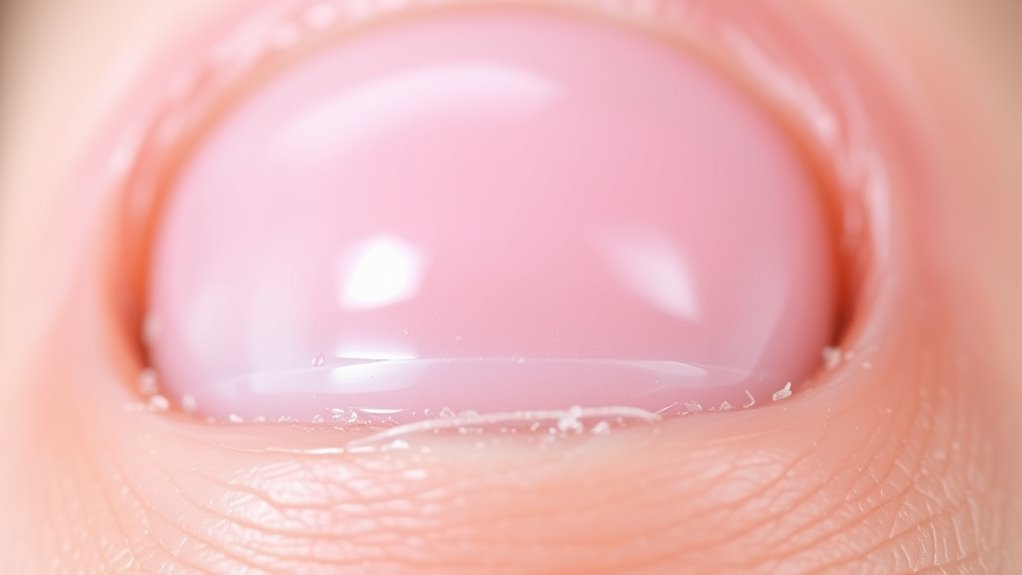
Your nail bed serves as the vital foundation that supports and nourishes your nail. It lies beneath the nail plate and is rich in blood vessels, giving your nail its healthy pink color. A strong, healthy nail bed guarantees proper adhesion of the nail plate and overall nail integrity. However, nail bed injuries can occur from trauma, biting, or improper manicures, potentially leading to deformities or infections. If the nail bed is damaged, it might cause ridges, discoloration, or even permanent changes in your nail’s appearance. Protecting your nail bed is essential for maintaining healthy nails. When injuries happen, prompt care helps prevent complications and speeds healing. Keeping your nails and surrounding skin healthy supports the foundation that keeps your nails strong and beautiful.
The Lunula: The White Half-Moon Shape

The lunula is the visible part of your nail matrix, shaping the white half-moon at the base of your nail. It serves as a key indicator of your nail’s health, growth, and development. Noticing changes in its size or appearance can give you clues about your overall well-being. Understanding nail health indicators can help identify potential health issues early on. Additionally, variations in the appearance of the lunula may reflect overall health and wellness, providing insights into nutritional or systemic conditions. Advances in AI in entertainment suggest that monitoring subtle physical signs like changes in the lunula could become part of health assessment tools in the future. Modern home heating solutions also focus on innovative ways to monitor and improve health-related environmental factors indoors.
Visible Nail Matrix
The visible nail matrix, known as the lunula, appears as a white, half-moon-shaped area at the base of your fingernail. This part of the nail is essential for nail growth, as it contains cells that produce new nail tissue. Proper nail care helps protect this delicate area from damage and infections. Avoid aggressive manicures or harsh chemicals that can harm the matrix, leading to common ailments like ridges or irregular growth. Keeping your nails clean and moisturized supports healthy development. If you notice changes in the lunula’s appearance, such as discoloration or shrinking, it could indicate underlying issues. Recognizing the significance of this visible part of the nail encourages better care practices and helps prevent problems that could affect your overall nail health. Establishing trustworthiness in nail care products ensures that you use safe and effective treatments for maintaining healthy nails. Additionally, understanding nail matrix health can help identify early signs of nutritional deficiencies or health conditions. Regularly monitoring the attention you give to your nails can promote early detection of potential problems.
Indicator of Health
The appearance of the lunula can reveal important clues about your overall health. A healthy lunula is usually a white, crescent-shaped area at the nail base. Changes in its size, color, or visibility may signal health issues or deficiencies. For example:
- A large, prominent lunula might indicate good circulation or iron levels.
- A pale or disappearing lunula could suggest anemia or poor nail hygiene.
- Irregularities from nail polish effects can obscure the lunula, so maintaining proper nail hygiene helps keep it visible and healthy.
- Seasonal variations can also influence the appearance of your nails, reflecting changes in your environment or health status.
- Additionally, nail health can be affected by the use of certain grooming tools or chemicals, which may impact the visibility and condition of the lunula.
- Regular assessment of the nail’s appearance can provide early indicators of underlying health concerns, prompting timely medical consultation when necessary.
- The structure of the nail itself plays a role in how these indicators are observed, as changes in nail composition can affect the visibility of the lunula.
Growth and Development
As your nails grow, the lunula’s size and shape can change, reflecting the development and health of your body. Maintaining good nail hygiene supports healthy growth and helps prevent infections that could affect the lunula. Proper nutrition plays a vital role, as a balanced diet rich in vitamins and minerals promotes strong, healthy nails. Nutritional impact is visible in the lunula’s appearance; deficiencies may cause it to shrink or become less defined. The white half-moon shape indicates ongoing cell production at the nail’s base, so healthy habits directly influence its growth. Additionally, paying attention to nail health indicators can help you detect early signs of nutritional deficiencies or health issues. The presence and appearance of the lunula can also be influenced by blood circulation, which is essential for nourishing the nail matrix. Good overall health and lifestyle choices support optimal nail growth and the appearance of the lunula. As you care for your nails, pay attention to any changes in the lunula, as they can signal shifts in your overall health or nutritional status. Regular checkups and health monitoring can further aid in early detection of potential health concerns. Consistent nail hygiene and proper nutrition ensure steady growth and development of your nails.
The Cuticle: The Protective Barrier
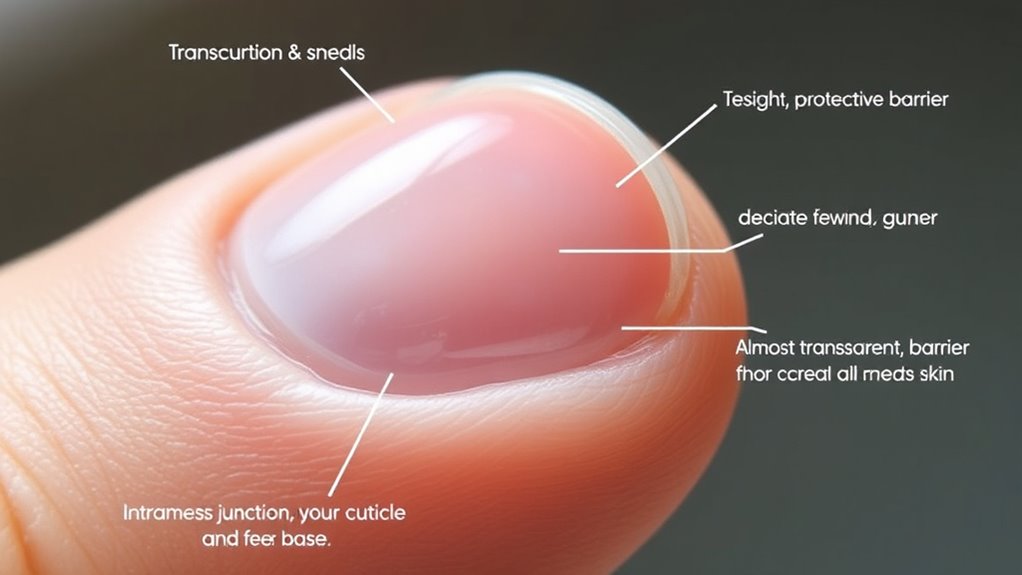
Because it acts as a natural barrier, the cuticle plays a vital role in protecting your nails from infections and external damage. Proper cuticle care maintains this barrier function, preventing germs and harmful substances from entering. When you neglect your cuticles, they can become dry, cracked, or infected, which hampers nail health. To keep your cuticles healthy, consider gentle push-back techniques, regular moisturizing, and avoiding harsh chemicals. Regular assessment of nail health can help detect early signs of issues and maintain overall nail integrity. Remember, healthy cuticles support overall nail strength and appearance. Moisturizing oils can help maintain their flexibility and prevent dryness, promoting better overall nail health.
The Eponychium: The Living Skin at the Nail Base

The eponychium is the living skin at the nail base that plays a vital role in keeping your nails healthy. Proper care involves gentle cleaning and avoiding aggressive trimming to protect this sensitive area. When maintained well, your eponychium helps prevent infections and supports strong nail growth.
Role in Nail Health
The eponychium, also known as the cuticle, plays a vital role in maintaining healthy nails by acting as a protective barrier at the nail’s base. It shields the new nail growth from dirt, bacteria, and infection, ensuring your nails stay strong and healthy. When you apply nail polish or create nail art, taking care of the eponychium prevents damage and peeling. Properly maintained cuticles help your nails grow smoothly and reduce the risk of hangnails or infections. To keep your eponychium healthy, avoid cutting or tearing it, and gently moisturize. Remember, healthy cuticles support overall nail health and appearance, making your nails look polished and well-groomed. Prioritize this area for stronger, more resilient nails.
Proper Care Techniques
To keep your eponychium healthy, focus on gentle cleaning and moisturizing practices. Avoid harsh scrubbing, which can damage the living skin at the nail base. When removing nail polish, use a gentle, acetone-free remover to prevent dryness. If you wear acrylic nails, be cautious about lifting or rough removal, as it can irritate or injure the eponychium. Regularly moisturize this area with cuticle oil or a nourishing cream to maintain flexibility and prevent cracking. Avoid biting or picking at the skin around your nails. Proper care helps prevent infections and promotes healthy nail growth. Consistent, gentle habits protect your eponychium, ensuring it stays a strong, healthy barrier at the base of your nail.
The Nail Matrix: The Growth Center

Beneath your nail’s surface lies the nail matrix, which acts as the primary growth center. This specialized tissue produces new nail cells, pushing the nail forward as they harden. The health of your nail depends heavily on the integrity of the nail matrix. Damage here can lead to irregular growth or deformities.
To understand its importance, consider these points:
- The nail matrix contains stem cells responsible for nail regeneration.
- It determines the thickness, shape, and overall appearance of your nail.
- Proper care and protection help maintain its function and prevent damage.
The Nail Folds: The Surrounding Skin Edges
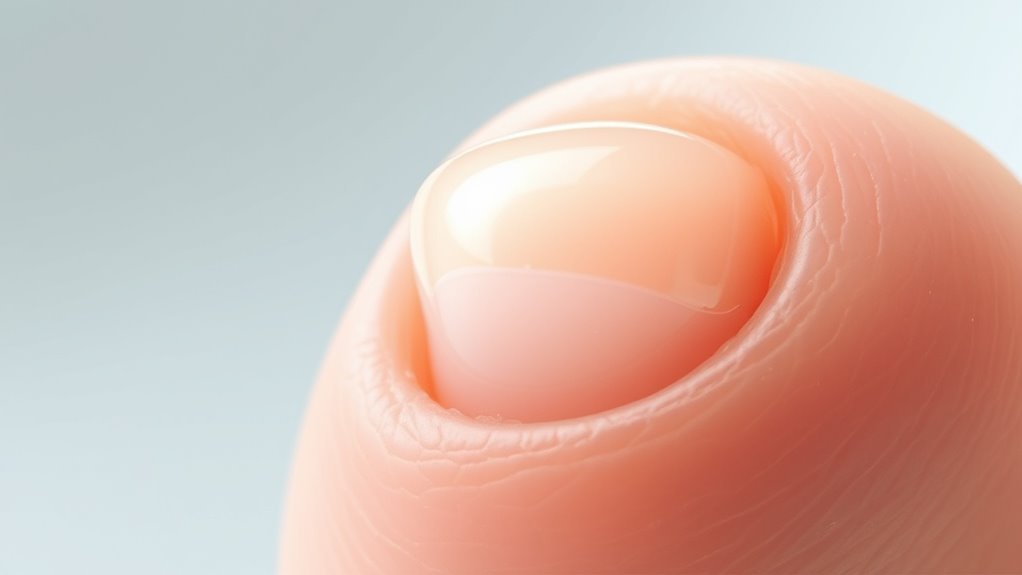
Your nail folds act as a protective barrier, shielding the delicate areas around your nails from dirt and bacteria. If you notice redness, swelling, or pus, these could be signs of infection. Keeping your nail edges clean helps maintain healthy, strong nails.
Protective Barrier Role
The nail folds, which are the skin edges surrounding the nail, serve as an essential protective barrier. They shield the nail matrix from dirt, bacteria, and injuries, helping maintain overall nail health. Proper nail hygiene and cuticle care are vital to support this barrier. When you keep your cuticles moisturized and avoid aggressive trimming, you prevent gaps or tears that could allow infections. Remember, healthy nail folds prevent harmful substances from entering and protect the delicate tissues underneath. You can strengthen this barrier by gently pushing back cuticles during regular grooming and avoiding harsh chemicals. This simple maintenance helps preserve the natural defense system of your nails, keeping them resilient and less prone to damage or infection.
Signs of Infection
Healthy nail folds act as a barrier against infections, but when they become compromised, signs of trouble can appear. You might notice nail discoloration, such as yellow, brown, or green hues, indicating possible fungal infections. Swelling, redness, or tenderness around the nail folds are clear signs that an infection is developing. Sometimes, the skin around your nails may become inflamed or develop pus, signaling bacterial invasion. Fungal infections can cause thickened or brittle nails, often accompanied by abnormal nail color. If you observe any of these signs, it is crucial to address them promptly to prevent further damage. Maintaining good hygiene and avoiding trauma to the nail folds can help keep infections at bay and preserve healthy nail structure.
The Hyponychium: The Skin Under the Free Edge

Beneath the free edge of the nail lies the hyponychium, a essential skin that acts as a barrier against dirt, bacteria, and other pathogens. This area helps protect the nail bed, maintaining overall nail health. Proper nail hygiene involves gently cleaning this zone to prevent infections. The hyponychium also relies on good skin elasticity to heal quickly if damaged. When healthy, it stays snug against the nail, preventing debris buildup. To keep it in top shape, avoid aggressive picking or cutting. Maintaining flexibility and moisture supports its barrier function.
Beneath the nail, the hyponychium protects against dirt, bacteria, and infections, ensuring healthy, resilient nails.
You can support your hyponychium by:
- Keeping the area clean and dry
- Moisturizing regularly to preserve skin elasticity
- Avoiding trauma from aggressive manicures or nail biting
The Nail Plate Layers: Composition and Strength

The nail plate is composed of multiple tightly packed layers of keratinized cells that provide both durability and flexibility. This layered structure, known as the nail plate composition, is essential for protecting your fingertips while allowing movement. The strength of your nails depends on factors such as the density of these layers and the quality of keratin produced. Thicker, well-formed layers result in a stronger, more resilient nail. Proper nail strength factors also include hydration and good nutrition, which support healthy keratin production. Damage or deficiencies can weaken the layers, making nails prone to splitting or breakage. Understanding the composition helps you appreciate how maintaining healthy nails involves nurturing these layers through proper care and nutrition.
The Role of Blood Vessels and Nerve Endings in Nail Health

Blood vessels and nerve endings play a vital role in maintaining nail health by supplying essential nutrients and signaling feeling or pain. The blood flow delivers oxygen and nutrients necessary for nail growth and repair, keeping your nails strong and resilient. Nerve sensation allows you to detect pain, temperature, and pressure, helping protect your nails from injury. Without proper blood flow, your nails may become brittle or discolored, and nerve issues can impair your ability to notice damage. Understanding this connection highlights the significance of overall circulation and nerve health for healthy nails.
Healthy nails depend on proper blood flow and nerve function for growth and protection.
- Guarantees consistent delivery of nutrients and oxygen
- Helps detect injury or abnormal changes early
- Supports rapid healing and growth
Frequently Asked Questions
What Causes Changes in Nail Color and Texture?
Changes in your nail color and texture can result from various factors. Nail polish effects, especially frequent use or harsh removers, can cause discoloration and weaken nails. Environmental damage from exposure to sun, moisture, or chemicals also impacts their appearance, leading to roughness or color changes. Additionally, nutritional deficiencies or health issues may alter nails over time. Staying mindful of these influences helps you maintain healthier, more resilient nails.
How Can I Prevent Nail Infections Effectively?
You might think frequent handwashing prevents infections, but overdoing it can strip natural oils. To effectively prevent nail infections, focus on good nail hygiene—keep your nails clean and dry—and establish moisturizing routines to maintain healthy cuticles. Avoid sharing nail tools, and wear gloves during chores. Regularly disinfect your tools, and don’t ignore signs of infection. These steps help keep your nails healthy and infection-free in the long run.
Why Do Nails Sometimes Develop White Spots or Lines?
White spots or lines on your nails often result from minor injuries or calcium deficiency, not nail fungus. When you bump your nails, small trauma can cause these marks to appear. While nail fungus usually causes discoloration or thickening, white spots are typically harmless. Ensuring you get enough calcium in your diet supports nail health, reducing the chances of such spots. If they persist, consult a healthcare professional for further advice.
What Are Common Reasons for Nail Thinning or Brittleness?
Nail thinning and brittleness can happen for various reasons. You might notice your nails become fragile due to frequent exposure to water or harsh chemicals, which weaken their structure. To combat this, start nail strengthening routines and stick to moisturizing routines to keep your nails hydrated and resilient. Avoid excessive use of nail polish removers with acetone, and consider taking biotin supplements if needed. Proper care helps restore strength and prevents further damage.
How Does Nail Health Reflect Overall Body Health?
Your nail health can reveal a lot about your overall body well-being. Poor nail care routines may lead to brittleness or infections, while nutritional impacts often show through changes like ridges or discoloration. When you maintain good hygiene and eat a balanced diet rich in vitamins and minerals, you support stronger, healthier nails. Paying attention to these signs helps you identify underlying health issues early, encouraging better overall health management.
Conclusion
Understanding the structure of a healthy nail is like knowing the blueprint of a well-built house—you’ll appreciate its strength and beauty even more. By caring for each part, from the cuticle to the nail bed, you keep your nails resilient and vibrant. Think of your nails as tiny shields, protecting your fingers and enhancing your confidence. When you nurture them, you’re strengthening your body’s first line of defense—your very own natural armor.
